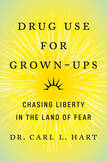Review: Is it high time to reconsider our drug policies?
Carl Hart, a neuropsychopharmacologist at Columbia University, begins Drug Use for Grown-Ups: Chasing Liberty in the Land of Fear with a unique admission: While some drug scientists occasionally speak of past drug use, he intends to discuss the titular subject in relation to his ongoing experience with several illicit psychoactive compounds, including “probably [his] favorite drug,” heroin.
In each of the first four chapters, Hart presents a prong of the problem with the approach in the United States to drug use: the “War on Drugs,” closeted use, harm reduction and the brain-disease model of addiction.
What he says about the first two should be largely uncontroversial for anyone sympathetic to drug policy reform. The war on drugs is now widely regarded as an abject failure, even in terms of its own stated aims and by some who were its erstwhile champions. Moreover, most drug policy reform advocates share Hart’s ire at the unequal application of drug war objectives, which has caused them to hit people and neighborhoods of color especially hard. And although some users with an interest in reputation management might feel a little stung by Hart’s critique of closeted use as cowardly, most of them would probably welcome a world in which they did not find it necessary.
Is the cost-benefit ratio of, say, alcohol really less than that of the drugs we stigmatize and criminalize?
But the last two prongs are real bones of contention in advocacy communities. Harm reduction—the idea that we should mitigate any deleterious impact of drug use instead of punishing users and perhaps even distributors—continually increases in popularity and is generally regarded as progressive, in all senses of the word.
The situation with the brain-disease model—according to which addiction is a disease that calls for compassion rather than a moral failure worthy of censure—is more complex. The debate over what precisely constitutes addiction, who is most susceptible to it and why is a lively one. Consequently, the brain-disease model has nothing like the appeal of harm reduction among advocates of drug policy reform. Nevertheless, it does enjoy support from some drug scientists and addiction specialists who share Hart’s reformist aims.
But for Hart, both ideas cede too much ground to the war on drugs by emphasizing the harms of controlled substances relative to their benefits, which are very real but often completely unknown or ignored in public discourse. As he says, “Addiction represents a minority of drug effects, but it receives almost all the attention.”
After delineating his position on these issues, Hart devotes the rest of the book to his experience with various illicit compounds and the science about them, some widely known (e.g., cannabis, cocaine and heroin) and some less so (e.g., amphetamines, cathinones like khat and “bath salts,” and 6-APB). His central thesis throughout is that “Grown-Ups”—those who “get ample sleep, eat nutritiously, and exercise regularly,” meet their responsibilities, plan their drug use to minimize disruptions, have no contraindications and are not in crisis—should be free to use presently controlled psychotropics without fear of penal repercussions or social stigma.
Hart’s book is well written and well argued, funny and human. But it is challenging. And it raises at least two points that merit discussion by the church and a thoughtful Catholic response.
Hart uses heroin intermittently to “inspire [him] to be a more empathetic person.” He even experimented with temporary dependency “to prove...that withdrawal was an inconvenience that could be dealt with.”
First, Hart is right that we inflate the dangers of substances our society stigmatizes while ignoring their medicinal and personal value. And although many families have been ravaged by opioid addiction in recent decades, he persuasively argues that misinformation occludes our understanding even of heroin. So my response to him is generally yes.
But this yes is not as stentorian as it could be, because I am thinking about the church’s position and role in these matters. The problem (if there is one) is that the church is not merely interested in those Hart calls Grown-Ups. Following the example of Jesus, we are, if anything, specifically interested in non-Grown-Ups, people who do not have their lives fully together and who need healing. Hart uses heroin intermittently to “inspire [him] to be a more empathetic person.” He even experimented with temporary dependency “to prove...that withdrawal was an inconvenience that could be dealt with.”
Hart knows that not everyone is so intentional, disciplined or self-aware, and that the above definition for Grown-Ups is fairly heroic. He narrows his scope to such individuals in part because the public conversation so rarely addresses them. But the church cannot narrow its scope in this way. What, then, should we say about loosening constraints on access to potentially dependency-causing compounds without appealing to the usual distortions Hart is trying to undermine? This is a hard question.
Second, Hart queries our society’s attitude toward chemical euphoria. Bluntly, he asks, “What’s wrong with getting high?” He stipulates, “To be absolutely clear, I also enjoy heroin for the mere pleasure of its effects.” While the church has long affirmed the rejuvenating value of pleasure, for most Catholics this sort of pleasure pursuit is probably a bridge too far. Hart is asking: Have we thought that through? Is the cost-benefit ratio of, say, alcohol really less than that of the drugs we stigmatize and criminalize?
For my own part, Hart’s distinction between “mere pleasure” and effects like inspiring empathy is too clean anyway; the pharmacology and ethics are interrelated. He speaks of nights by the fireplace with a few lines of heroin: “In these serene moments, I reflect on my day, hoping that I wasn’t the source of anyone’s anguish.” But it is precisely the serenity—the pleasure—of these moments that allows for the empathetic retrospection. The deepest pleasure always has this sort of impact. So, to adapt Hart’s driving question, how might temporary chemical euphoria align with Catholic teloi? How might such pleasure be therapeutic in the deepest sense of the beatific vision?
Even if the answer to these questions is ultimately “It can’t,” we will be better for having explored them anew rather than assuming our understanding of these substances is complete in the face of evidence to the contrary. That, besides a really good read, is what Hart is trying to provide.
This article also appeared in print, under the headline “High Time to Reconsider Drug Policy?,” in the Spring Literary Review 2022, issue.











